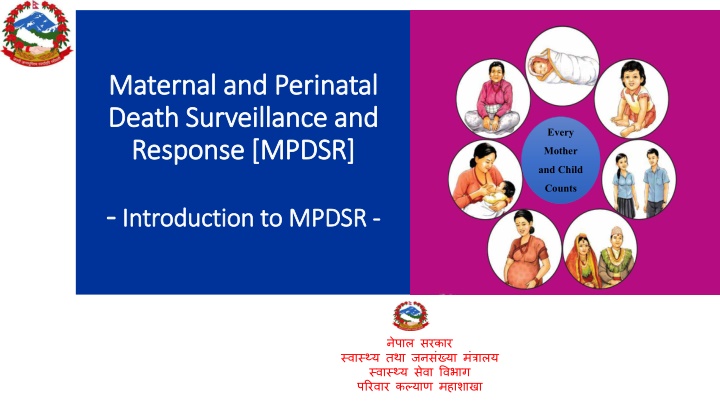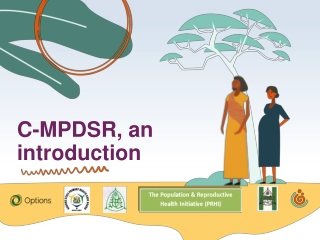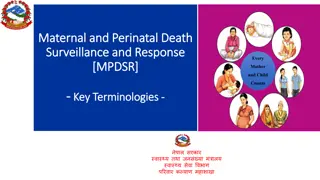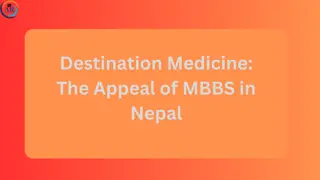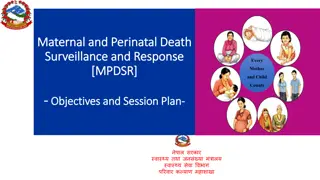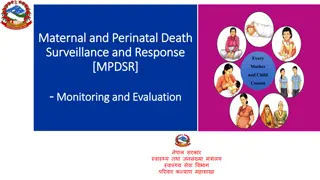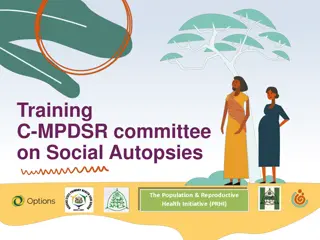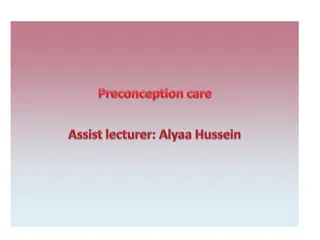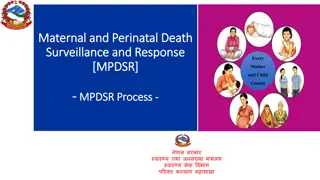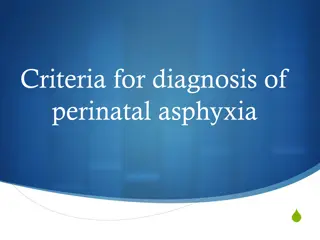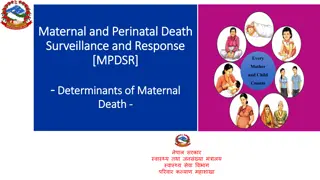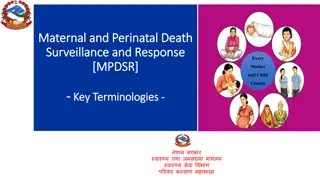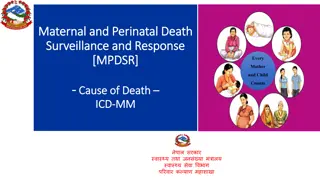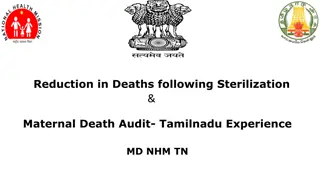Maternal and Perinatal Death Surveillance and Response (MPDSR) in Nepal
Explore the maternal and perinatal mortality status in Nepal, learn about the MPDSR's rationale, goal, components, and implementation status. Dive into a case scenario highlighting maternal deaths, background on maternal mortality, and global statistics, emphasizing the importance of improving maternal and child health outcomes.
Download Presentation

Please find below an Image/Link to download the presentation.
The content on the website is provided AS IS for your information and personal use only. It may not be sold, licensed, or shared on other websites without obtaining consent from the author.If you encounter any issues during the download, it is possible that the publisher has removed the file from their server.
You are allowed to download the files provided on this website for personal or commercial use, subject to the condition that they are used lawfully. All files are the property of their respective owners.
The content on the website is provided AS IS for your information and personal use only. It may not be sold, licensed, or shared on other websites without obtaining consent from the author.
E N D
Presentation Transcript
Maternal and Perinatal Maternal and Perinatal Death Surveillance and Death Surveillance and Response [MPDSR] Response [MPDSR] Every Mother and Child Counts - - Introduction to Introduction to MPDSR MPDSR - -
Session Objectives By the end of the session, the participants will be able to Describe the status of maternal and perinatal mortality in Nepal, Describe the rationale, goal, objectives and components of MPDSR and Share the implementation status of MPDSR in Nepal.
Case Scenario A 26-year old had her third baby at home. Her first baby died after a difficult delivery. Her second baby was premature and survived. During this pregnancy, she attended one antenatal care at the local health center on her fifth month. She started bleeding 1 hour after delivery of a healthy baby. The local skilled birth attendant (SBA) came within 1 hour. She found the woman very pale and collapsed and gave her oxytocin and misoprostol and referred her to the district hospital.
Case Scenario contd.. Her husband refused to take her to the hospital and it took 2 hours to convince her husband. She died on the way to hospital. Her family and the village grieved for her death. 2. After three months, another maternal death occurred in the village due to similar cause of hemorrhage.
Questions What was the cause of the first mother s death? Was her death preventable? How? What could have been done to prevent the second mother s death?
Background Development of any country is reflected by the status of health of mothers and children
Maternal Mortality: What & How Much Is It? During Postpartum Period During / After Abortion During Pregnancy During Delivery Globally, about 3 lakh women die every year due to maternal cause 99% of such maternal deaths occur in less developed countries Maternal Morality Study 2021: In Nepal, 622 maternal deaths (653 Pregnancy Related Deaths)
MMR: Where are we Italy, Belarus, Norway, Poland Greece, Israel Spain, Sweden Australia, Belgium, Japan, Netherland, Switzerland China 2 South Sudan Sierra Leone Nigeria Bangladesh India Nepal 1150 1120 917 173 145 174 3 4 5 29 Nepal Post Census Maternal Mortality Study 2021 151 Source: Trends in Maternal Mortality, 1990 - 2020, WHO, UNICEF,UNFPA, WB
Questions answered by Maternal Death Review Questions answered by Maternal Death Review Who are dying? Where are women dying? When (stage of pregnancy) are women dying? What is the main cause of death?
Rationale of MPDSR Rationale of MPDSR Sustainable Development Goals has targets to reduce MMR to 70 per 100000 live births by 2030. Institutional delivery to 90% by 2030. It is possible to achieve the targets if MPDSR is effectively implemented. Achievements MMR: NDHS, UN Estimates 2017 Achievements Institutional delivery: NDHS 2022, NMICS 2019 Annual rate of reduction: 6.4% (UN Estimate 2017) 600 100 90 90 79 539 500 80 70 60 57 MMR/100,000 LB 400 55 60 281 258 259 300 50 35 40 170190 200 151 30 18 20 11 100 70 10 0 0 1996 2006 2011 2014 2015 2016 2021 2030 Achievements . Targets (SDG) MMR Institutional delivery
Maternal and Perinatal Mortality Perinatal deaths (MPDSR) (FY 2077/78) Total reported: 944 Stillbirth: 726 Antepartum: 522 Intrapartum: 204 MNH Section, Family Welfare Division, 2077/78 11 MoHP, NSO. (2022). National Population and Housing Census 2021: Nepal Maternal Mortality Study 2021. Kathmandu: Ministry of Health and Population; National Statistics Office.
Maternal Mortality (MMS 2021) 12 MoHP, NSO. (2022). National Population and Housing Census 2021: Nepal Maternal Mortality Study 2021. Kathmandu: Ministry of Health and Population; National Statistics Office.
MPDSR: Definition MPDSR: Definition Continuous identification, notification, quantification and determination of causes and avoidability of all maternal and perinatal deaths, as well as the use of this information to respond with actions that will prevent future deaths
MPDSR: Goal To eliminate preventable maternal and perinatal mortality by obtaining and using information on each maternal and perinatal death to guide public health actions and monitor their impact
MPDSR: Objectives MPDSR: Objectives To count every maternal and perinatal death, permitting an assessment of the true magnitude of maternal and perinatal mortality and the impact of actions to reduce it. To provide information that effectively guides immediate as well as long-term actions to reduce maternal mortality at health facilities and community and perinatal mortality at health facilities.
Components of MPDSR Components of MPDSR 1. Identify cases & notify 6. Monitor, Evaluate & Refine 2. Collect Information 5. 3. Analyze information Implement solution 4. Recommend solution
MPDSR and MPDSR and QoC QoC MDSR can improve the quality of care provided to pregnant women by identifying gaps in health services that contributed to a maternal death.
Key Principles / Concepts of MPDSR Key Principles / Concepts of MPDSR No woman should die giving birth No punitive action No name Every death counts No blame Black Box Beyond the numbers Not used for litigation Every death has a lesson
Implementation status Implementation status 2009 MPDR 1996 MPDR 6 14 Districts Community 2013 MPDR 2015 MPDSR 77 hospitals 2012 MPDR Maternity 1990 MDR Hospitals Hospitals MPDSR 6 National Guideline Hospitals Hospitals Hospital Districts 2016 2020 12 42 21 2022: MPDSR in 27 Districts & 94 hospitals
MPDSR Implementing Facilities and Districts MPDSR Implementing Facilities and Districts Hospitals: 94 Districts: 27
Maternal and Perinatal Maternal and Perinatal Death Surveillance and Death Surveillance and Response [MPDSR] Response [MPDSR] Every Mother and Child Counts - - MPDSR Situation Analysis MPDSR Situation Analysis- -
Findings from MPDSR Findings from MPDSR 2078 / 79 2078 / 79 (N=178) (N=178)
MPDSR MPDSR (N=94) MPDSR Implementation Status in Hospitals (N=94) 25 90 86 72 21 67 80 20 18 70 60 15 60 14 15 13 50 50 12 12 42 40 22 9 9 10 7 30 6 6 5 20 5 2 10 0 0 Koshi Province Madhesh Province Bagmati Province Gandaki province Lumbini Province Karnali Province Sudurpaschim Province MPDSR hospitals in FY 2078-79 Hospitals reporting Maternal Deaths Reporting status (%)
MPDSR MPDSR (N=27) MPDSR Implementation Status in Districts (N=27) 9 120 8 8 100 100 100 7 6 80 5 5 63 5 4 60 60 4 50 50 3 3 3 3 40 2 2 2 1 1 1 1 20 1 0 0 0 0 Koshi Province Madhesh Province Bagmati Province Gandaki province Lumbini Province Karnali Province Sudurpaschim Province MPDSR districts in FY 2078-79 Districts reporting Maternal Deaths Reporting status (%)
35% 31% 30% 24% 25% (N=178) (N=178) Maternal Death Reporting in Provinces 20% 17% 15% 10% 10% 8% 8% 5% 2% 0%
35% 33% 30% 26% 25% Age at Death (N= (N=178 178) ) 20% 18% 15% 10% 10% 7% 6% 5% 0% 15-19 yrs 20-24 yrs 25-29 yrs 30-34 yrs 35-39 yrs 40-44 yrs
?: (N= Who are dying? (N=178) ?: (N=178 178) ) 33% 35% 30% 24% 25% 20% 18% 20% 15% 10% 3% 5% 1% 1% 0%
(N= (N=178 178) ) Place of Delivery (N=178) 45% 41% 40% 35% 30% 25% 21% 19% 20% 15% 7% 7% 10% 4% 5% 1% 0%
31% 34% Antepartum period (N= (N=178 178) ) Period of Death (N=178) Intrapartum period PP upto 48 hrs after delivery PP after 48 hrs of delivery 5% 30%
(N= (N=178 178) ) Place of Death (N=178) 60% 51% 50% 40% 33% 30% 20% 6% 10% 3% 3% 3% 0.5% 0.5% 0%
Cause of Death (N=178) 2%2% 1%1% Non-obstetric complications, ICD-MM 7 Hypertensive disorders of pregnancy, ICD-MM 2 9% Obstetric hemorrhage, ICD-MM 3 29% Other obstetric complications, ICD-MM 5 Pregnancy related infections, ICD-MM 4 17% Pregnancy with abortive complications, ICD- MM 1 Coincidental cause, ICD-MM 9 Unanticipated complications of management, ICD-MM 6 Unknown, unspecified cause, ICD-MM 8 21% 18%
Perinatal Death Reporting Status by Province (N=1646) 25 100% 21 90% 83% 86% 20 80% 18 67% 70% 15 15 14 15 60% 60% 12 12 50% 50% 9 9 42% 10 40% 7 6 6 30% 5 5 20% 1 11% 10% 0 0% Koshi Madhesh Bagmati Gandaki Hospitals reporting Perinatal Deaths Lumbini Karnali Sudurpaschim MPDSR hospitals in FY 2078-79
Perinatal Death Distribution (N=1646) 12% 19% Early Neonatal Death (<=1 day) Early Neonatal Death (>1 day) 17% Antepartum Still Birth Intrapartum Still Birth 52%
Final cause of Perinatal Death (N=1646) 40% 34% 35% 30% 23% 25% 20% 16% 13% 15% 9% 10% 5% 5% 0% Complications of prematurity Birth Asphyxia Congenital anomalies Infection Other causes Cause not specified
Challenges to MPDSR Implementation Challenges to MPDSR Implementation Lack of ownership at various levels Under reporting of maternal deaths Blame culture at some places that inhibits health professionals and others from participating fully in the MPDSR process Inadequate staff numbers, resources and budget Problems of geography and infrastructure. Delay in review of Maternal deaths Delay/Incomplete notification, screening, VA, review, response & use of web- based MPDSR system Transition into federal system brings need to change in national guidelines as well as orientation and trainings in provincial and local levels. 35
Actions taken following MPDSR review Actions taken following MPDSR review Central level: 1. Strengthening of MPDSR in hospitals and districts through refresher orientations and onsite coaching 2. Expansion of MPDSR in hospitals and districts 3. Plan to develop PPH and Pre-eclampsia / eclampsia package Hospitals: 1. Orientation to resident doctors and nurses of different departments on MPDSR 2. All interns, junior residents and nurses trained in neonatal resuscitation 3. 24 hrs on floor duty for faculty doctors for prompt management and additional nursing staff in labor room for better monitoring 4. Mandatory 24 hr duty for Obstetricians and Gynaecologists and 5. Mandatory 24 hr duty for Medical Officers in maternity wards and NICU
Hospitals: 6. Pediatricians to attend all deliveries 7. Increase in number of delivery tables, patient beds and dedicated beds for neonatal care 8. MICU with ventilator within Obstetrics and Gynaecology department 9. Plan to establish/upgrade infrastructure for birthing unit/SNCU in referral hospital 10. Strengthening referral mechanism: circulate phone numbers of referral hospitals in hospitals 11. Availability of emergency medicines, equipment, and adequate necessary instruments 12. Mandatory to call the hotline number of CEONC hospitals before referral 13. Presence of a healthcare worker during referral- as far as possible 14. To conduct regular CME for skill update
Hospitals: 15. Increase in number of staff for ANC to improve quality service 16. Emphasis on counseling for prenatal screening of mother during ANC visits 17. Mandatory to do ECG in all cases with high blood pressure and those requiring caesarean section 18. Plan to establish/upgrade infrastructure for birthing unit/SNCU in referral hospital 19. Strengthening referral mechanism: circulate phone numbers of referral hospitals in hospitals 20. Availability of emergency medicines, equipment, and adequate necessary instruments 21. Mandatory to call the hotline number of CEONC hospitals before referral 22. Presence of a healthcare worker during referral- as far as possible 23. To conduct regular CME for skill update
Local level: 1. Free calcium to pregnant women in some local levels 2. Established fund for poor in some local levels 3. Depending on economic condition, one side travel to CEONC site free of cost during referral 4. Free ambulance for maternity cases in some local levels 5. Initiated Upa-mayor Koseli Karyakram - hygiene kit/ nutrition package/ package for newborns and mothers 6. Recruitment of Obstetrician and Gynaecologist at local level facility 7. Initiated specialized mobile clinic every month 8. Plan for establishment of birthing centre at wards with maximum maternal deaths 9. To initiate Khushaal pariwaar program for high-risk group in some local levels: from conception till vaccination of children
